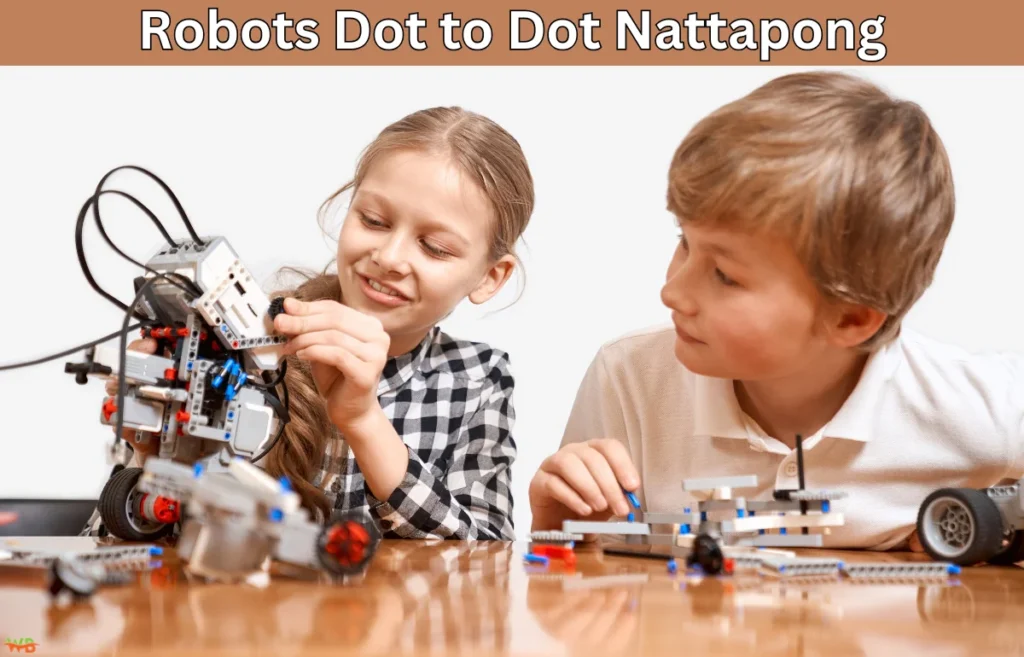In today’s fast-evolving world, where technology is intricately woven into education, “Robots Dot to Dot Nattapong” is an innovative concept that combines the power of robotics, art, and cognitive development. This fascinating fusion offers children, educators, and enthusiasts an exciting opportunity to enhance creativity, problem-solving abilities, and STEM skills through an engaging and interactive learning experience. In this article, we will explore how “Robots Dot to Dot Nattapong” functions as a unique educational tool, benefiting all participants while fueling curiosity and fostering learning.
What is Robots Dot to Dot Nattapong?
At its core, Robots Dot to Dot Nattapong is an activity designed to stimulate both artistic creativity and cognitive growth. Participants connect a series of dots on a page, following a specific sequence that ultimately forms an image. The twist, however, lies in the fact that these activities often incorporate robotic themes, allowing users to explore how robots work while having fun.
This form of interactive learning can take place through digital applications, worksheets, or even hands-on activities where robots themselves participate in drawing the images. The beauty of this concept is that it merges the traditional dot-to-dot activity—popular for enhancing fine motor skills—with the intriguing world of robotics, helping children and learners discover technology in a playful, accessible way.
The Power of Robotics and Art Combined
Why Integrating Art with Robotics Enhances Learning
Combining art and robotics in a single activity, such as Robots Dot to Dot Nattapong, offers a plethora of benefits. The traditional dot-to-dot activity fosters creativity, attention to detail, and hand-eye coordination. When you add the robotics element, it transforms the experience, as children learn about programming, engineering, and problem-solving—all while enjoying the artistic process.
The fusion of art and technology can significantly enhance children’s cognitive development. As they connect dots to form a robot-themed picture, they engage multiple parts of their brain. This encourages the development of critical thinking, spatial awareness, and fine motor skills. Plus, children are not just passive learners—they are actively involved in creating and understanding how technology works.
Cognitive Benefits of Robots Dot to Dot Nattapong
The cognitive benefits of Robots Dot to Dot Nattapong are undeniable. When children engage with dot-to-dot puzzles, they enhance their concentration, boost memory, and develop sequencing skills. These activities also encourage perseverance and patience, as completing the task requires careful attention to detail.
Furthermore, by incorporating robotics into these tasks, kids are introduced to fundamental principles of science, technology, engineering, and mathematics (STEM). They learn how robots are built and programmed, helping them connect the dots between abstract concepts and real-world applications.
Transforming Education with Robots Dot to Dot Nattapong Activities
Integrating Robots Dot to Dot in Educational Settings
For educators, Robots Dot to Dot Nattapong offers a wealth of teaching opportunities. Teachers can use this concept to create dot-to-dot worksheets that feature robots, guiding students through concepts like geometry, sequencing, and coding.
Here are some ways teachers can incorporate this activity into the classroom:
1. Classroom Worksheets with Robotic Themes
Teachers can design dot-to-dot worksheets that incorporate robot shapes or related themes. This will not only make the activity more exciting but will also help students develop essential skills like counting, sequencing, and recognizing geometric shapes.
2. Using Robotics for Drawing
For a more advanced challenge, students can use small robots like Sphero or Lego Mindstorms to follow a specific path that completes a dot-to-dot puzzle. This hands-on approach allows students to write simple code to direct the robot, merging robotics with creativity.
3. Group Projects and Collaboration
To deepen the learning experience, students can work in teams to design their dot-to-dot challenges, combining robotics and art. This fosters teamwork and helps students learn how to collaborate effectively while integrating STEM concepts.
How Can Parents Use Robots Dot to Dot Nattapong at Home?
Fun and Educational Family Activities
Parents can also integrate Robots Dot to Dot Nattapong into home activities. These interactive tasks provide an excellent opportunity for families to bond while promoting cognitive development and creativity. Here are some ideas for parents to explore:
1. Dot to Dot Worksheets at Home
Parents can print robot-themed dot-to-dot worksheets and complete them with their children. This simple yet engaging activity can be done after school, during weekends, or as part of a family game night. It’s a great way to combine fun and learning, allowing kids to improve their focus and fine motor skills.
2. Digital Platforms and Apps
There are several apps and digital platforms available that offer interactive Robots Dot to Dot Nattapong activities. These platforms can add an extra layer of engagement, allowing children to digitally connect dots and watch a robot complete the image on screen.
3. Incorporating Art
After completing a robot dot-to-dot puzzle, parents can encourage children to color in the image, further enhancing their artistic creativity. This can also be an opportunity to discuss different aspects of robotics, allowing children to ask questions and learn more about the technology involved.
Robots Dot to Dot Nattapong for Enthusiasts: Exploring Advanced Possibilities
Innovative Robotics Projects
For those with a deeper understanding of robotics, Robots Dot to Dot Nattapong offers an exciting chance to explore advanced projects. Enthusiasts can use robotics to automate the dot-to-dot process, turning it into a full-scale engineering challenge. Here are a few advanced applications:
1. Programming Robots to Complete Dot to Dot Puzzles
Enthusiasts can design their dot-to-dot puzzles using 3D software and then program robots to complete them. This offers a practical lesson in programming, robotics design, and problem-solving.
2. Using Laser Cutters and 3D Printers
For a truly cutting-edge project, you can use tools like laser cutters or 3D printers to create physical dot-to-dot puzzles. These tools allow enthusiasts to design intricate robot-themed puzzles and automate their creation with advanced robotics.
3. Augmented Reality (AR) Experiences
Looking ahead, the integration of augmented reality (AR) into Robots Dot to Dot Nattapong could revolutionize the experience. By using AR, users could interact with a robot through their devices, visualizing the completed puzzle in a virtual space. This would offer a more immersive and dynamic experience for both students and enthusiasts.
The Future of Robots Dot to Dot Nattapong: A World of Possibilities
As technology continues to evolve, Robots Dot to Dot Nattapong is poised for even greater innovation. The integration of advanced technologies such as AR, machine learning, and robotics programming offers exciting possibilities for the future.
How Augmented Reality Will Shape the Future
The potential for AR to transform the world of Robots Dot to Dot Nattapong is immense. Imagine using AR glasses or a mobile device to see your robot puzzle come to life in 3D. As learners complete the dot-to-dot activity, they could interact with the image and even manipulate the robot in real-time, enhancing both the educational and entertainment aspects.
This technology could allow learners to take their creativity to new heights, building and coding their robots in a virtual space before bringing them to life in the real world.
Conclusion: Robots Dot to Dot Nattapong – A Future-Forward Learning Tool
In conclusion, Robots Dot to Dot Nattapong represents a groundbreaking approach to learning. By combining robotics, art, and cognitive development, it offers a unique way to engage students, parents, and enthusiasts alike in meaningful, hands-on learning experiences. From enhancing cognitive abilities to promoting STEM education, this innovative activity can help nurture a generation of creative problem-solvers and tech enthusiasts.
As technology continues to advance, the potential for Robots Dot to Dot Nattapong to evolve into more immersive and interactive experiences grows. By embracing this fusion of art and technology, we pave the way for a future where creativity, curiosity, and education are seamlessly intertwined. So, whether you are an educator, a parent, or an enthusiast, consider incorporating Robots Dot to Dot Nattapong into your learning journey—it’s an investment in both creativity and technology.
FAQs
1. How do dot-to-dot activities support cognitive development?
- Dot-to-dot activities improve focus, memory, and concentration, while also enhancing fine motor skills and spatial awareness. They help children develop problem-solving abilities and understand patterns, which are key cognitive skills.
2. What role does robotics play in early education?
- Robotics introduces children to STEM concepts in an interactive way, fostering curiosity about technology and teaching foundational skills in programming, engineering, and critical thinking.
3. Are there age limits for using robotics learning tools?
- Robotic tools are adaptable for various age groups. Younger children can focus on simple tasks, while older kids can dive into more complex challenges like programming and building robots.
4. Can robotics activities promote teamwork?
- Yes, many robotics tasks encourage group work, helping children improve communication, problem-solving, and collaboration skills while working together on challenges.
5. How can parents use robotics in daily routines?
- Parents can use apps, toys, or interactive kits to introduce kids to basic robotics and coding. Activities like building robots or completing challenges can make learning fun and part of everyday life.
Learn about Retro Bowl 3kh0

Ton Roobprom is an experienced writer focused on practical advice across technology, business, travel, beauty, lifestyle, and home improvements. He specializes in distilling complex subjects into clear, actionable insights to help you enhance your daily life.
Discover more from Wellbeing Junction
Subscribe to get the latest posts sent to your email.


